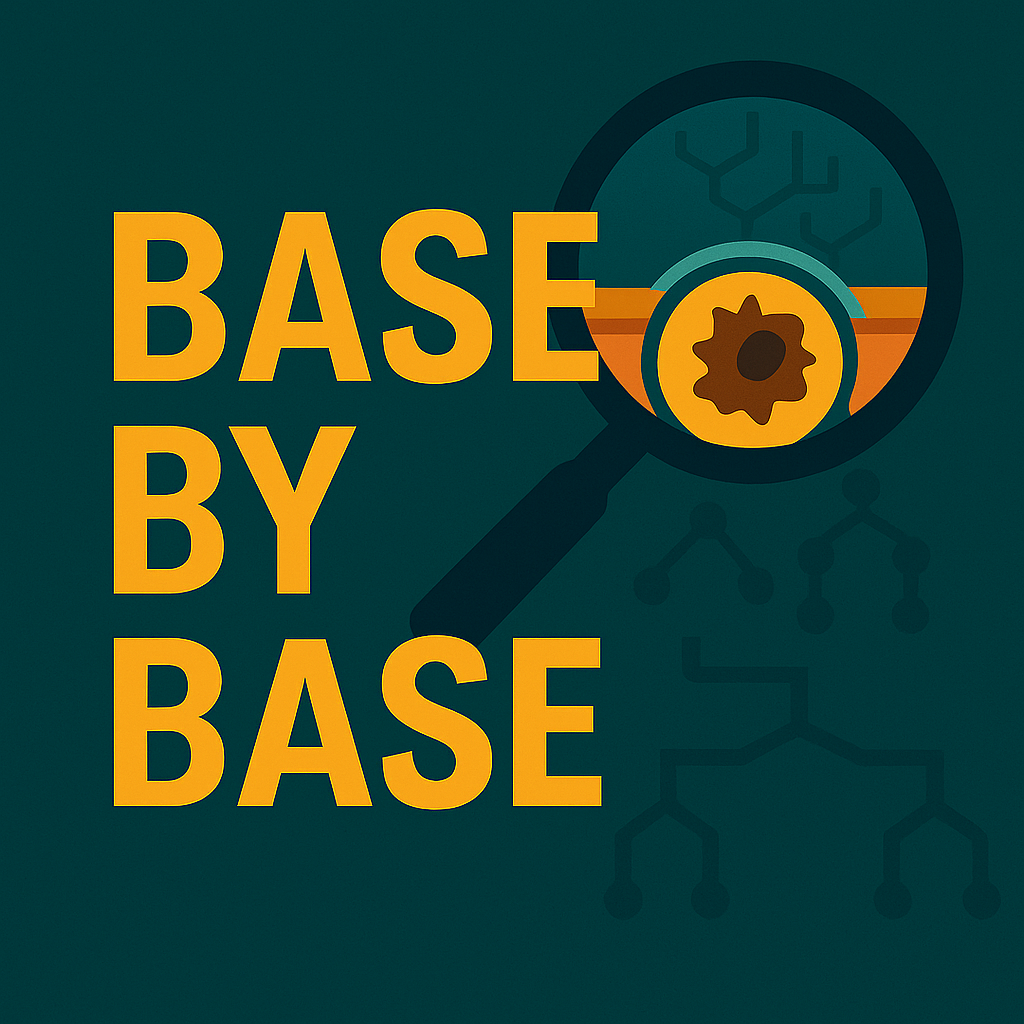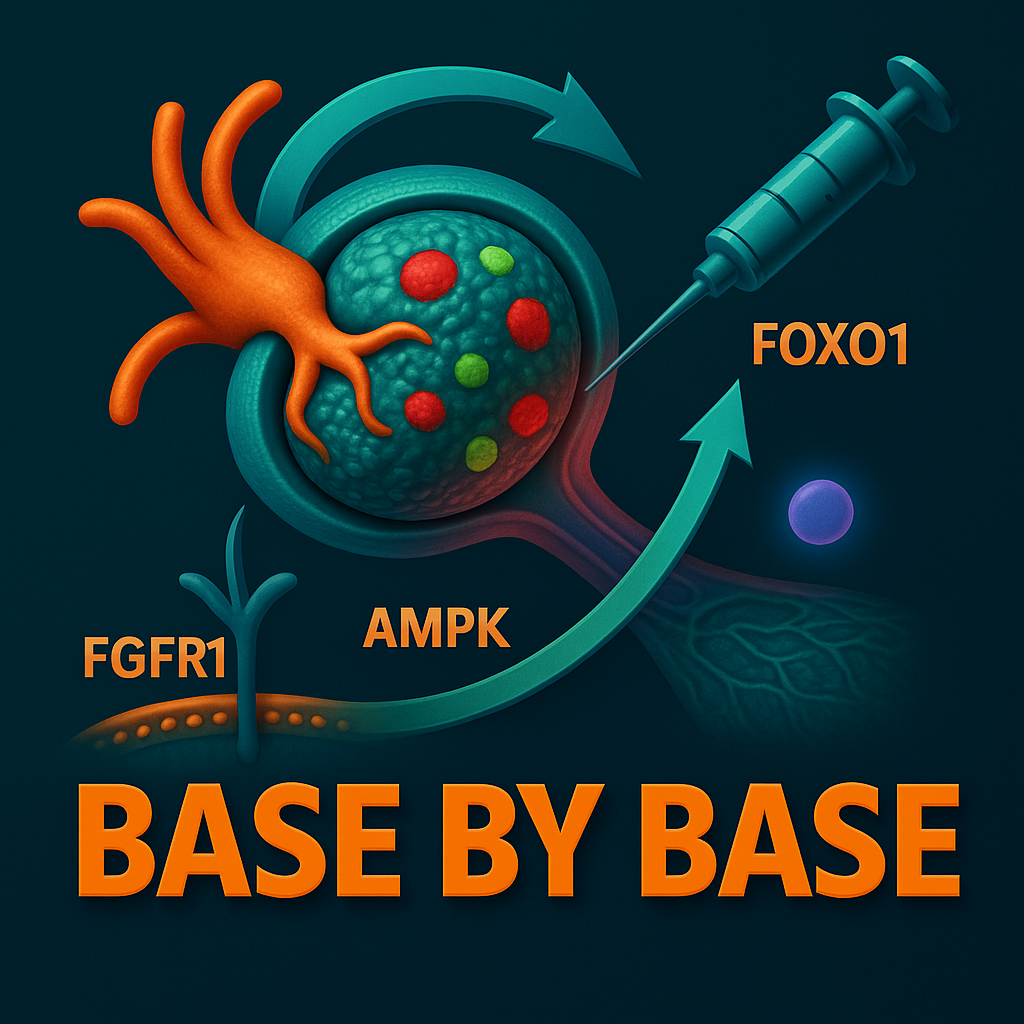Episode Transcript
[00:00:14] Speaker A: Welcome to Base by Bass, the papercast that brings genomics to you wherever you are. Today we're diving into a really groundbreaking area where the intricate world of our genes meets the complex landscape of our brains. Have you ever wondered why, you know, a particular treatment for a brain condition can work wonders for one person, yet seemingly fall flat for another? Or perhaps how a seemingly small difference in brain structure might actually hold clues to our unique predispositions? Imagine if we could zoom in not just on the brain's physical structure, but directly into its cells, seeing which specific genes are active in different regions, and then connect that directly to someone's unique brain anatomy and maybe even their behavior. Well, this isn't just some futuristic dream. It's the rapidly advancing frontier of personalized medicine. Our deep dive today explores how new technology is making this incredibly detail level of insight a reality, potentially paving the way for highly targeted and truly effective therapies. And here's where it gets really interesting, how the very thickness of your brain's outer layer, the cortex, might be intimately linked to the unique genetic symphony playing within.
So today we celebrate the groundbreaking work of a collaborative research team led by Christine Ecker and colleagues. They have affiliations spanning institutions like the University Hospital of the Goth University in Frankfurt am Main, King's College London, Institut Pasteur, and Radboud University Medical center, among others.
Real powerhouse team.
[00:01:37] Speaker B: Absolutely. They have truly advanced our understanding of how to bridge that gap between brain structure, gene expression, and importantly, clinical symptoms. Their work really aims to revolutionize drug discovery and personalized interventions for complex brain conditions, moving us away from those sort of one size fits all approaches.
[00:01:55] Speaker A: Okay, let's try and unpack this fascinating challenge then. For a long time, understanding the brain has felt a bit like trying to solve an incredibly complex puzzle with, well, critical piece is missing. Right.
On one hand, we have these amazing imaging techniques, things like MRI scans that show us the brain's macroscopic structure and function. These visible patterns are often called imaging derived phenotypes or IDPs. And on the other hand, we have the intricate world of genomics giving us the blueprint of life, the genes themselves. But the big question had always been, how do we meaningfully connect these two scales? How do we link what we see on a brain scan to the, you know, molecular activity happening at a genetic level?
[00:02:36] Speaker B: Precisely. Precisely. That's really been the holy grail. The real challenge is finding a way to bridge those macroscopic brain patterns, which are so clear in our imaging, with the underlying molecular mechanisms, particularly gene expression. This emerging field Is called imaging transcriptomics.
[00:02:52] Speaker A: Imaging transcriptomics. Okay.
[00:02:54] Speaker B: Yeah. It's all about combining high resolution brain maps with detailed gene activity profiles. Researchers often tap into massive open access databases like the Allen Human brain atlas ahba, which meticulously maps gene expression across the human brain. But here's the kicker. Until now, the full potential of these combined insights for truly guiding drug discovery for conditions affecting the central nervous system, or cns, has been, well, largely underexplored.
[00:03:23] Speaker A: Right. So if they're bridging this gap, what's the fundamental problem they're aiming to solve for people actually experiencing these brain conditions?
[00:03:30] Speaker B: Well, the core problem is that many CNS drugs are, to put it simply, broad stroke. They kind of cast a wide net affecting many parts of the brain in general ways. And this is often why different people respond so differently to the same medication or why side effects could be so prevalent. We desperately need a way to develop more targeted therapies.
[00:03:48] Speaker A: Makes sense.
[00:03:49] Speaker B: And this study isn't just theorizing. It proposes a robust analytical framework that allows for what they call pharmacotranscriptomics in vivo.
[00:03:58] Speaker A: In vivo. So in living people.
[00:04:01] Speaker B: Exactly. Think about that. Understanding how drugs interact with an individual's unique genetic landscape while they are alive, Rather than just in a petri dish or from postmortem brain samples. It's potentially a game changer for precision medicine.
[00:04:17] Speaker A: Wow. Okay. And to demonstrate this powerful new framework, they chose to focus on a specific system within the brain. Right. Why that particular one?
[00:04:26] Speaker B: Yes. They zeroed in on GABA A receptors or GAB rs. These are absolutely critical for brain inhibition. You can sort of think of them as the brain's brakes, helping to calm down neural activity.
[00:04:35] Speaker A: The brain's brakes. I like that.
[00:04:37] Speaker B: Yeah. And what's fascinating about gabars is that they're not just one single entity. They're composed of different subunits, like different lego bricks, if you will, that can be assembled in unique ways. And critically, these subunits are expressed differently across various brain regions. For instance, receptors containing the Alpha 2 subunit, they're found mostly in the limbic brain regions, Areas vital for emotion and memory. And these are linked to anxiolytic or anti anxiety effects.
[00:05:05] Speaker A: Okay.
[00:05:06] Speaker B: On the other hand, Those with the Alpha 1 subunit are more widespread across the entire cortex and are associated with sedative, amnesic, and anticonvulsive effects.
[00:05:15] Speaker A: So different jobs in different places.
[00:05:17] Speaker B: Precisely. This incredible regional specificity and their distinct roles made gabars an ideal target to test their sophisticated new framework.
[00:05:26] Speaker A: That deep dive into gabars really Highlights the complexity. So how did they actually manage to connect all these dots from the, you know, incredible, incredibly detailed level of gene expression to the physical brain structure, and then finally to human behavior? What was the secret sauce?
[00:05:40] Speaker B: Well, their approach is truly innovative and computationally pretty powerful. First, they took the existing HBA data, which is kind of like scattered dots of gene expression information on a map, and they transformed it. They used sophisticated statistical mapping tools. Gaussian process regression, or ordinary kriging for those interested to meticulously fill in all the spaces. This created an ultra detailed, smooth genetic fingerprint for virtually every tiny point on the brain's entire surface.
And they even accounted for the brain's complex folds using something called geodesic distance. This makes the maps incredibly precise and true to the brain's actual shape. They generated these incredibly rich maps for over 15,000 genes.
[00:06:25] Speaker A: 15,000 genes mapped like that?
That sounds like an astronomical amount of data. How do they even begin to analyze that, let alone link it to something as complex as brain imaging patterns?
[00:06:34] Speaker B: Yeah, it's a huge data set. So to handle it and effectively link it to those imaging patterns, the IDPs, they systematically compared several statistical strategies for what they called transcriptomic decoding, basically ways of assessing spatial correlations. How much does the gene map match? The brain structure map.
[00:06:55] Speaker A: Okay.
[00:06:56] Speaker B: And as a benchmark, they validated their methods against the well established human serotonergic system, the 5ht system.
[00:07:02] Speaker A: Why that system?
[00:07:03] Speaker B: Because its gene expression and protein distribution, how they map onto the brain, are very well understood and known to correlate nicely. It was like a known puzzle solution to check if their new technique worked properly.
[00:07:15] Speaker A: Got it. Like a quality control check. And what was their chosen strategy? Once they tested it out, they found.
[00:07:20] Speaker B: That a gradient based approach provided the best balance of, well, accuracy, sensitivity, and also computational efficiency, which is important with so much data.
[00:07:28] Speaker A: Right.
[00:07:29] Speaker B: So instead of trying to analyze all 15,633 genes individually, which would be like trying to read every single word in a massive library at once, Is that possible? Pretty much. They found a clever way to simplify this massive genetic data set.
They decomposed the complex gene expression signatures into a smaller, more manageable set of nine underlying master patterns, or CO expression gradients.
[00:07:52] Speaker A: Nine patterns instead of 15,000 genes.
[00:07:55] Speaker B: Exactly. And together, these nine patterns captured about 41% of the total variability in gene expression across the brain. This significantly reduced the computational load while still capturing crucial patterns. And it also helped them use models that avoid misleading or false correlations, which is really important. This kind of Analysis.
[00:08:14] Speaker A: Okay, that makes sense. So once they had their validated method, how did they apply it specifically to the GABA A receptors, the brains breaks that you mentioned earlier?
[00:08:22] Speaker B: Right back to the Gabbers. They then applied their gradient based decoding to a high resolution PET atlas of Gabar benzodiazepine binding sites. They specifically focused on 13 cortical GABR subunit genes. And what's fascinating here is they used hierarchical clustering.
[00:08:39] Speaker A: Clustering, like grouping things together?
[00:08:40] Speaker B: Yes, exactly. Grouping these subunits based on the similarities in their unique high resolution MRNA expression profiles across the cortex. Think of it like seeing which Lego legs for Gabars tend to appear together or in similar locations across the brain map they created.
[00:08:56] Speaker A: Ah, I see. So they could literally see natural patterns in how these Gabbard genes were expressed. Almost like finding an intrinsic code.
[00:09:05] Speaker B: Precisely. They identified two distinct classes of GABBAR subunits, each with a unique and consistent cortical expression pattern.
[00:09:11] Speaker A: Okay, two classes. And then the link to people.
[00:09:14] Speaker B: Yes, the link to actual human behavior. They took neuroanatomical imaging data, specifically cortical thickness measurements from a large cohort of 279 individuals. These individuals ranged in age from 7 to 31, which is a good developmental range. And critically, they also had self reported anxiety and depression scores.
[00:09:33] Speaker A: Okay.
[00:09:34] Speaker B: Then they standardized the CT measures accounting for typical brain development, age, sex and iq. This step was crucial because it allowed them to see individual deviations from the norm. How much thicker or thinner someone's cortex was compared to what you'd expect.
[00:09:48] Speaker A: Right. Isolating the individual variation.
And then came the moment of truth. Looking for connections between these individual brain structure deviations and the highly specific gene expression patterns they'd mapped.
[00:10:01] Speaker B: Precisely. This is where it all came together. They stratified individuals into two distinct subgroups based on how their individual cortical thickness patterns spatially aligned with those two newly identified GAB R subunit clusters.
[00:10:15] Speaker A: So seeing if a person's unique brain architecture mirrored one of those specific genetic signatures they found.
[00:10:21] Speaker B: Exactly. It was about connecting the dots from gene map to brain structure map to individual experience.
[00:10:27] Speaker A: So after all that incredibly complex mapping and analysis, what were the big aha moments? What did they actually discover when they finally put all these intricate pieces together?
[00:10:36] Speaker B: Well, the first major aha was actually the validation of their method itself. All their decoding techniques, particularly their chosen gradient based approach, reliably detected significant spatial correlations between gene expression and protein binding for that serotonergic system test case.
[00:10:52] Speaker A: The quality control check worked.
[00:10:53] Speaker B: It did? Yeah. And this was crucial. It confirmed that Their incredibly detailed gene expression maps were indeed accurate reflections of where these important receptors were actually distributed in the brain. And it meant their genetic fingerprinting was spot on.
[00:11:08] Speaker A: Okay, method validated. That's good. Now for the gabars, the main event.
[00:11:12] Speaker B: Right. This is where the clinical relevance really starts to emerge. They confirmed that the GABAR subunits indeed clustered into two distinct groups based on their gene expression profiles.
[00:11:22] Speaker A: The two classes you mentioned?
[00:11:23] Speaker B: Yes. Cluster 1, which includes subunits like Alpha 2, Alpha 3, Alpha 5 and others, showed elevated gene activity primarily in limbic brain regions.
[00:11:32] Speaker A: Limbic? So emotion and memory centers.
[00:11:35] Speaker B: Exactly. Areas like the anterior temporal lobes and entorhinal cortex, which we know are absolutely crucial for processing emotions and forming memories. Then there was cluster two. This one, containing subunits like alpha one, alpha four and gamma two, displayed elevated gene expression more broadly across the cortical hemisphere, especially in areas like the occipital lobes at the back of the brain.
[00:11:56] Speaker A: Okay, so it's not just different genes, but different geographies of gene activity within the brain related to these GABA receptors.
[00:12:03] Speaker B: That's a great way to put it. Different geographies.
[00:12:05] Speaker A: But what did this incredibly detailed molecular map mean for the individuals they studied? How did it connect to their real world experience, like anxiety or depression?
[00:12:15] Speaker B: This is the critical behavioral link. And it's quite striking. They found that individuals could indeed be divided into two neuroanatomically distinct subgroups based on how their cortical thickness patterns align with these two gabar clusters. Okay, so subgroup one, which included 178 individuals, showed greater cortical thickness than expected upon positive deviation from the typical developmental trajectory.
[00:12:39] Speaker A: Thicker cortex in some areas than expected.
[00:12:42] Speaker B: Yes. And this atypical thickness was positively correlated with increased gene activity in that limbic Gabar cluster 1. The emotional centers. Again.
[00:12:50] Speaker A: Ah. Okay.
[00:12:51] Speaker B: And crucially, adults in this particular subgroup exhibited significantly elevated self reported levels of anxiety and depression compared to those in subgroup 2.
[00:13:00] Speaker A: Wow. So a direct link there. What about subgroup 2?
[00:13:03] Speaker B: Subgroup 2, the remaining 101 individuals, showed positive correlations between their cortical thickness patterns and the more widespread cortical GAB or cluster two. And importantly, this group did not show the same elevated anxiety and depression levels.
[00:13:17] Speaker A: So let me see if I've got this straight. If your limbic brain regions, those areas tied to emotion, had an atypical thickness, and that thickness pattern correlated with this specific genetic signature for cluster 1 gabars, you were statistically more likely to report anxiety and depression symptoms, especially as an adult.
[00:13:37] Speaker B: You've got it. That's a very direct link they found, and it was specific. The more significant that positive deviation in cortical thickness was in those limbic regions, the higher the anxiety levels reported by those individuals.
[00:13:48] Speaker A: And this wasn't seen for the other cluster?
[00:13:50] Speaker B: No. This powerful relationship was not observed for the more widespread cluster too. What this suggests is a profound and specific link between molecular expression patterns in particular brain circuits, how those brain break subunits are deployed, and concrete clinical symptoms like anxiety and depression.
[00:14:07] Speaker A: That's huge. It's a huge step towards understanding the biological underpinnings of these complex conditions, isn't it?
[00:14:13] Speaker B: It really is. If we connect this to the bigger picture. This study isn't just a fascinating piece of neuroscience. It demonstrates a robust and incredibly efficient analytical framework for truly integrating gene expression and high resolution brain imaging.
It moves us leaps and bounds closer to understanding the molecular roots of brain organization and crucially, how that organization links directly to conditions like anxiety and depression. It's like building a brand new kind of bridge in brain science.
[00:14:44] Speaker A: And the ultimate transformative goal of this kind of research is personalized treatment, isn't it moving beyond that trial and error medicine we often see?
[00:14:51] Speaker B: Absolutely. The implications are profound.
These findings strongly suggest that the specific cortical transcriptomic landscape, essentially the unique genetic fingerprint of genes encoding for pharmacological targets like those gabars, could serve as a powerful indicator of a drug's potential clinical and behavioral relevance for an individual.
[00:15:10] Speaker A: So like a predictive map?
[00:15:12] Speaker B: Sort of, yeah. This opens up a future avenue for guiding the development of highly targeted pharmacotherapies and truly personalized interventions.
Instead of the current one size fits all approach, imagine a future where drugs are designed to act on specific Gabar subunits in specific brain regions, precisely tailored to an individual's unique genetic and structural brain profile. That's revolutionary potential.
[00:15:36] Speaker A: It really is. And this also seems to refine our understanding of those crucial Alpha 1 and Alpha 2 subunits you mentioned earlier, doesn't it, Giving us a more nuanced view of their roles?
[00:15:46] Speaker B: It definitely does. You know, previous research had broadly linked alpha 1 subunits to sedative effects and alpha 2 to anxiolytic antianxiety effects.
[00:15:55] Speaker A: Right.
[00:15:55] Speaker B: This study expands on that by showing these distinct behavioral effects may actually be mediated through two different neural systems with largely non overlapping cortical expression signatures. Different geographies, as you put it.
[00:16:06] Speaker A: Ah, so the geography matters for the effect.
[00:16:08] Speaker B: It seems so. The alpha 2 subunits primarily influence limbic system functions, which, as we discussed, are key for emotion regulation, whereas alpha 1 subunits appear to impact more general region overarching neural functions. It helps clarify how these different brain breaks might be working in different parts of the brain to produce different outcomes. It's more complex than we thought.
[00:16:31] Speaker A: This research paints such a compelling picture of the future.
But as always in science, what are the immediate next steps for this kind of work? What fundamental questions does this exciting new framework raise that need to be answered?
[00:16:44] Speaker B: Yeah, great question. This raises a truly important point. While they found incredibly strong correlations between cortical thickness variability and variations in GABAergic genes, correlation doesn't necessarily mean causation.
[00:16:57] Speaker A: The classic mantra.
[00:16:58] Speaker B: Exactly. So future research needs to really dig into the causal mechanisms and pathways that truly link specific genes to these imaging derived phenotypes.
How does the gene's activity actually lead to a change in cortical thickness? That's a big unknown. And perhaps most crucially, for clinical application, the current findings are from a cross sectional study, meaning just a snapshot in time. The absolutely vital next step will be to apply this model to longitudinal data sets observing individuals over time, especially before and after receiving pharmacotherapy.
[00:17:30] Speaker A: So, tracking people?
[00:17:31] Speaker B: Yes, tracking people to see how these relationships hold up over time, and particularly how they might predict response to treatment. That would be essential for truly assessing its potential for guiding personalized treatment strategies in real world clinical settings. We need to see if these genetic fingerprints can actually predict treatment success.
[00:17:50] Speaker A: That makes complete sense. So, pulling all these threads together, what's the fundamental takeaway we should grasp from this deep dive? What's the core message?
[00:17:58] Speaker B: I think the core message is that this deep dive reveals a powerful new framework, a way to link detailed brain imaging data with the genetic blueprint of key neurotransmitter systems like the GABA system. And it specifically shows how the unique gene expression patterns of these GABA receptor subunits are tied to distinct brain structures and even behavioral traits like anxiety. It's like having an ultra high resolution map of the brain that combines both its physical roads, if you like, and the precise genetic instructions for building and operating them.
[00:18:27] Speaker A: Exactly. It's a combined map structure and genetics. So picture this a future where your brain's unique genetic fingerprint guides the precise treatment you receive, turning those broad stroke therapies into ultra targeted interventions designed specifically for you. That's the powerful potential this new kind of map opens up for conditions like anxiety and depression. This episode was based on an Open Access article under the CC BY 4.0 license license. You can find a direct link to the paper and the license in our episode description. If you enjoyed this, follow or subscribe in your podcast app and leave a five star rating. If you'd like to support our work, use the donation link in the description.
Thanks for listening and join us next time as we explore more science base by base.
Sam.




